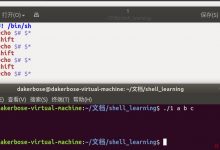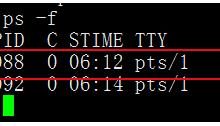实例
下面是一个简单的脚本,脚本中 processid 函数的作用是查询指定进程名字的进程ID,在管理linux服务器的过程中,这个是很常见的功能,processid 函数作用是利用多层管道命令查询进程ID,以下是测试脚本源码
#!/bin/shprocessid(){ipid=$(ps -ef | grep -w $1 | grep -v grep | awk \'{print $2}\')echo $ipid}case \"$1\" ini)processid $2;;*)echo \"parameter error..$1\";;esac
执行脚本
我们执行这个脚本查询 zone9_log1 的进程ID,下面是执行的结果
[wanng@localhost ~]$ ./a.sh i zone9_log1130530 144391 144392
为了和 zone9_log1 进程实际的进程ID对比,我们单独执行 ps -ef | grep -w zone9_log1 | grep -v grep | awk \'{print $2}\’ 命令,执行结果如下:
[wanng@localhost ~]$ ps -ef | grep -w zone9_log1 | grep -v grep | awk \'{print $2}\'130530
问题
同样的命令,确得到了不同的结果,我们在脚本中加入 tee 命令输出管道的中间结果,调整之后的的脚本如下:
processid(){ipid=$(ps -ef | grep -w $1 | tee out1 | grep -v grep | tee out2 | awk \'{print $2}\') | tee out3echo $ipid}case \"$1\" ini)processid $2;;*)echo \"parameter error..$1\";;esac
再次执行脚本,本地会生成 out1 out2 out3 三个文件,记录这管道命令的中间结果,下面是脚本执行结果以及 out1 out2 out3 文件的内容
[wang@localhost ~]$ ./a.sh i zone9_log1130530 144885 144886[wang@localhost ~]$ cat out1wang 130530 1 0 4月24 pts/10 00:07:47 ./zone9_log1 ./zone9_log1.luawang 144885 109338 0 20:45 pts/8 00:00:00 /bin/sh ./a.sh i zone9_log1wang 144886 144885 0 20:45 pts/8 00:00:00 /bin/sh ./a.sh i zone9_log1wang 144888 144886 0 20:45 pts/8 00:00:00 grep -w zone9_log1[wang@localhost ~]$ cat out2wang 130530 1 0 4月24 pts/10 00:07:47 ./zone9_log1 ./zone9_log1.luawang 144885 109338 0 20:45 pts/8 00:00:00 /bin/sh ./a.sh i zone9_log1wang 144886 144885 0 20:45 pts/8 00:00:00 /bin/sh ./a.sh i zone9_log1[wang@localhost ~]$ cat out3130530144885144886[wang@localhost ~]$
原因
执行脚本的时候,默认会创建一个新的shell(也即一个新的进程),上面的脚本 a.sh 就是在新的shell环境中执行的。从上面的测试结果可以看出,ps -ef | grep -w zone9_log1 命令的结果中包含了执行脚本身启动的进程和我们要查询的目标进程,我们只需要过滤掉脚本本身的进程,就可以得到准确的进程ID,调整之后的脚本如下(暂时先保留 tee命令输出的中间结果):
processid(){ipid=$(ps -ef | grep -w $1 | grep -v $0 | tee out1 | grep -v grep | tee out2 | awk \'{print $2}\') | tee out3echo $ipid}case \"$1\" ini)processid $2;;*)echo \"parameter error..$1\";;esac
上面processid函数中 grep -v $0 作用是过滤掉脚本的名字,其中 $0 表示脚本的名字 ( a.sh )
验证
再次执行脚本,结果如下:
[wanng@localhost ~]$ ./a.sh i zone9_log1130530[wanng@localhost ~]$ cat out1wanng 130530 1 0 4月24 pts/10 00:07:51 ./zone9_log1 ./zone9_log1.luawanng 146170 146168 0 21:11 pts/8 00:00:00 grep -w zone9_log1[wanng@localhost ~]$ cat out2wanng 130530 1 0 4月24 pts/10 00:07:51 ./zone9_log1 ./zone9_log1.lua[wanng@localhost ~]$ cat out3130530
从上面的测试结果中看出,最后输出的结果是正确的
总结
多层管道在shell脚本中是很常见的用法,使用起来也非常方便和高效的,但是脚本一旦出问题调试就会变得困难起来,合理的使用 tee 命令输出管道的中间结果,可以快速的定位问题所在
以上就是如何利用 tee 命令调试shell脚本中的管道的详细内容,更多关于tee 命令调试shell脚本中的管道的资料请关注脚本之家其它相关文章!
您可能感兴趣的文章:
- Shell脚本中管道的几种使用实例讲解
- Shell脚步攻略之管道重定向基础
- PowerShell管道入门必看篇(管道例子大全)
- linux shell 管道命令(pipe)使用及与shell重定向区别
- PowerShell实现按条件终止管道的方法
- PowerShell中终止管道的方法
- PowerShell入门教程之PowerShell管道介绍
- Windows Powershell导出管道结果
- Windows Powershell过滤管道结果
- shell脚本一键同时推送代码至github和gitee的解决办法
 爱站程序员基地
爱站程序员基地


